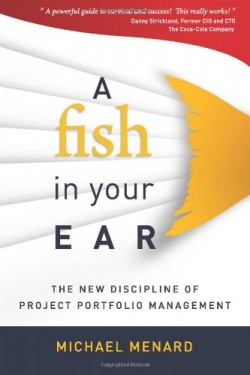After reading the first three chapters of A Fish In Your Ear, I stopped reading it for about a year. A lot of time is spent discussing the psychology of decision making, which is not often covered in the PPM literature, but it wasn’t enough to keep my attention. I came back to the book a year later and am glad I did because the best part of the book is in chapters 4-7.
Chapter 4 describes the importance of managing portfolio data, data integrity, and how to collect the right data. He opens up the chapter with a great quote by Bill Gates, “How you gather, manage, and use information will determine if you win or lose.” Early on Menard mentions that an organization’s central nervous system is its information management system and that an organization is only as effective as its knowledge is good. After a solid discussion on variables, data integrity, data-quality influencers, and other items he concludes the chapter on data collection. The list of questions in this section is one of the gems of the book. Menard does a great job of highlighting how asking the right questions can uncover the data needs of the organization.
Chapter 5 builds on chapter 4 and discusses decision criteria. Having the right information is important, but it is even more important that senior leaders have defined and agreed-upon criteria to discriminate between projects. In the middle of the chapter he gives a great explanation for why having clear objectives is a necessity for making the right decisions. “Once we clarify our objective and can clearly state and compare it to alternatives, it becomes a guiding star helping us navigate to our chosen destination.”
Chapter 6 continues with a good discussion of data visualization. I fully agree that in order to make sense of so much data, it has to be visualized. Not only GenSight, but companies like Tableau are working hard to help users visualize data. The results can be very enlightening. In this chapter, Menard discusses the various elements to help visualize data: color, shapes, size, and matrices. He concludes with visual rules: give people what they want, show what matters, make it rich, make it valid, and have a purpose.
Chapter 7 focuses on portfolio selection. He brings up two burning questions early in the chapter: “will this portfolio deliver our strategic goals?” and “do we have enough appropriate resources to execute the portfolio?” The first question touches the matter of what the organization should do, the second on what they can do. The second half of the chapter provides a great discussion on the matter of portfolio optimization.
In short, chapters 4-7 of A Fish In Your Ear are worth the price of the book and provide some of the best explanations of collecting and utilizing portfolio data that I have read. Rating: 4 out of 5 stars.
- Prioritize Projects With A Scoring Model - October 11, 2018
- A Guide to Building a Project Prioritization Scoring Model - September 4, 2018
- Know The Difference Between Work Intake Versus Stage-Gate - April 1, 2018


Thank you for the compelling review, Tim! I added the book to my reading list!